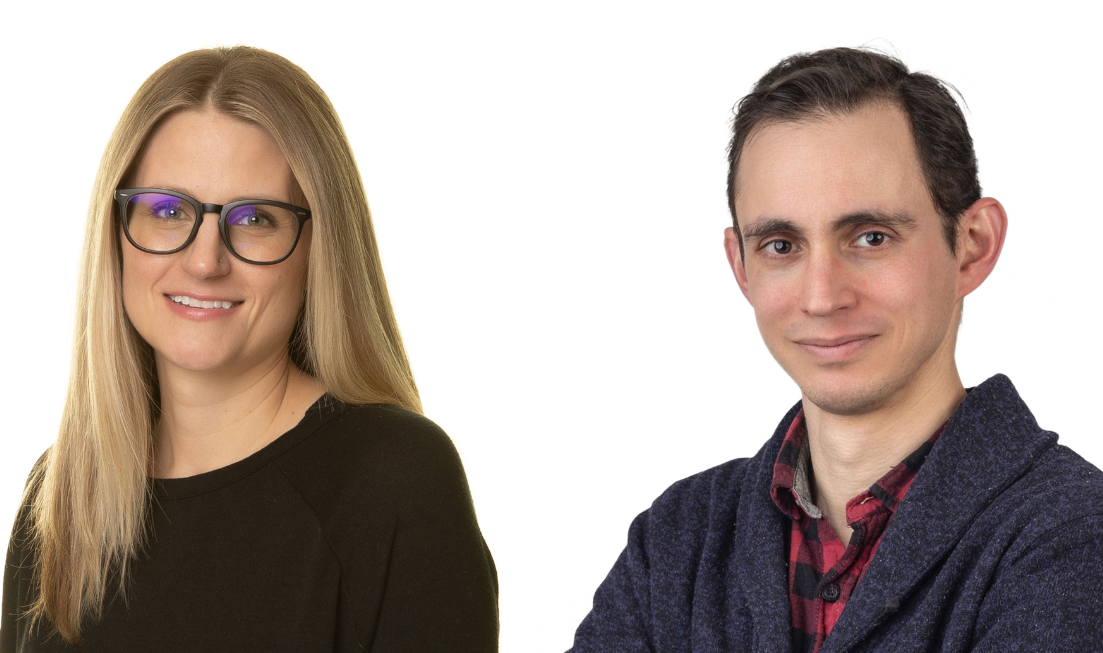Two McMaster researchers awarded prestigious HFSP grants

Lindsay Kalan and Jonathan Cannon are among only five researchers across Canada to receive funding from the highly competitive global program.
BY Blake Dillon and Jay Robb
July 9, 2025
At a Hamilton-area daycare, Lindsay Kalan and Jonathan Cannon pass each other in the parking lot at dropoff. They smile, nod, and carry on with their day.
What they don’t know is that when they get in their cars, they’ll both drive to McMaster University. They don’t know that they both run highly successful labs on campus, and they don’t know they’re both about to be awarded prestigious research grants from the Human Frontier Science Program (HFSP) — two of only five such grants in Canada this year.
“When the HFSP announced this year’s grant recipients, Jonathan and I connected over coffee to discuss our work,” Kalan says.
“The next day, we saw each other again at our kids’ daycare, and it wasn’t until then that either of us realized that we’d met before.”
The odds of such a small-world coincidence are remarkable, given the sprawling reach of HFSP grants, which demand international and interdisciplinary collaborations on research with global impact: Kalan is collaborating with research teams from Scotland and Germany, and Cannon is working with a research team in Denmark.
The HFSP is a highly competitive program — only 30 of 718 international research teams received funding this year.
“That two of these grants came to McMaster speaks to the university’s reputation internationally and reinforces the fact that we’re doing high-calibre and impactful interdisciplinary research,” Kalan says.
Kalan and Cannon are the third and fourth McMaster scientists to receive HFSP grants, after John Whitney and Kathryn Grandfield in 2021.
Here’s what they’ll be working on with these prestigious grants.
The smell of fear
Like many animal species, humans display distinct cues when we’re afraid: We sweat, our breathing quickens, and our nervous system activates. But not all our fear signals are so easily discernible.
When we’re afraid, we also emit molecules called volatile organic compounds, or VOCs — chemicals that burst into the air and evaporate at room temperature.
Some VOCs carry very subtle odours — it’s how dogs and other animals can “sense” fear in us. But much about these fear-scented molecules remains unknown, including where they come from and how we release them.
One hypothesis is that they’re actually released not by our bodies per se, but from the skin microbiome — the bustling communities of bacteria and other microbes that live on and under our skin.
Kalan, an associate professor in the Department of Biochemistry and Biomedical Sciences and a member of the Michael G. DeGroote Institute for Infectious Disease Research, is investigating this theory through a new $1.67 million HFSP grant.
“If these signals are in fact coming from the skin microbiome, we want to know which molecules are involved and which microbes are producing them,” Kalan says.
Working with a social psychologist from the University of Stirling in Scotland and an atmospheric chemist from the Max Planck Institute for Chemistry in Germany, the research team will expose a large study group to scary film scenes or personal phobias and monitor the air for VOCs during fear spikes.
The research team will also collect samples from different skin sites of participants, including the underarms, to determine changes in the behaviour of the skin microbiome during the expression of these VOCs.
Once the team determines which microbes are associated with the VOC fear signals, they will validate their findings in Kalan’s lab at McMaster.
“Our plan is to use our very large collection of skin and wound bacteria, human skin models, and sweat and sebum media to try to reproduce these fear-associated VOCs in the lab,” Kalan says.
If successful, this work will lead to the definitive characterization of a functional human “chemosignal” — or pheromone — for the first time ever.
The research team believes that this study could also pave the way for other important studies, ranging from microbiome manipulation to early infection detection.
“This is fundamental research in an area that’s been largely unexplored,” Kalan says. “Identifying the molecules and microbes associated with fear would be a significant step toward advancing our understanding of how bacteria and other microorganisms can mediate communication between humans in a non-verbal or non-visual way.”
The biological basis of rhythm
When we listen to music, we quickly feel the underlying beat. The beat makes us want to move along, and when we do, we find that we can take steps or bob our head in precise anticipation of the rhythmic sounds.
Evolutionarily, our sense of rhythm has been linked to adaptations that have made the human lineage uniquely successful, including language development and upright walking.
But how does the human brain make these moment-by-moment sound predictions, and why is auditory rhythm so closely connected with body movement?
To answer these questions, Cannon, an assistant professor in the Department of Psychology, Neuroscience and Behaviour, is collaborating with Dan Bang, an associate professor with the department of Clinical Medicine at Aarhus University in Denmark.
The chemical messenger dopamine could be the key to solving this long-standing puzzle, says Cannon.
Dopamine levels in a deep brain area called the “basal ganglia” are understood to play an important role in our capacity to make, evaluate, and learn from predictions; they are also believed to be important in motivating and selecting bodily actions.
Until now, researchers didn’t have the methods to directly investigate the relationship between dopamine and the human sense of rhythm.
The Cannon and Bang labs are joining forces to use a cutting-edge electrochemical approach to measure sub-second dopamine dynamics in the basal ganglia of patients who are undergoing awake brain surgery as part of their treatment.
Patients who volunteer to participate in the research will listen to and tap along with different rhythms.
Cannon and Bang will analyze the relationships between rhythms, movements, and dopamine, and compare what they see to what their models predict.
“The results will help us to develop models that more accurately describe the role of dopamine in human rhythm and in the brain at large,” says Cannon.
“Our project will represent a step change in our understanding of the neurobiology of human rhythm and provide first-of-their-kind data points from the human brain on dopamine at the intersection of perception, cognition, and action.”
“This will deepen our understanding of the biological basis of rhythm, central to music, dance, speech, and many other human activities. It will also provide general insights about dopamine, which may help us better understand dopamine-related disorders like Parkinson’s disease and how best to treat them.”


